#Bergère #Chair #Origins #Enduring #Elegance
Few chairs capture the grace and comfort of 18th-century French design like the Bergère. With its deep upholstered seat, enclosed arms, and exposed wood frame, the Bergère blends form and function in timeless style. But where did this elegant chair come from, and what does its name actually mean? In this post, we explore the history, name, and enduring charm of the Bergère chair—an icon of French craftsmanship and interior refinement.
What Is a Bergère Chair?
A Bergère is a fully upholstered French armchair with closed sides, a separate seat cushion, and a visible wooden frame. Its design offers generous comfort and was made for lounging. Unlike the open-armed fauteuil, the Bergère wraps around the sitter with upholstered armrests and deep proportions.
French craftsmen designed the chair for use in salons and private sitting rooms, where comfort mattered as much as aesthetics. Carved wood, plush upholstery, and flowing lines define the classic Bergère.
Where the Bergère Chair Originated
Furniture makers first created the Bergère during the reign of Louis XV in the early 18th century. At that time, French interiors shifted away from stiff, formal seating toward more relaxed and intimate furniture. The Rococo movement influenced this change, favoring comfort, soft lines, and a sense of movement in design.
Parisian ébénistes—elite cabinetmakers—crafted Bergère chairs for aristocrats and wealthy clients. These artisans used walnut, beech, or fruitwood for the frames and finished them with paint, gilding, or natural polish. Artisans padded the seats with horsehair or feathers and covered them in luxurious textiles like silk, tapestry, or painted canvas.
What Does “Bergère” Mean?
The word Bergère translates to “shepherdess” in French. While the connection between a formal armchair and a shepherdess may seem odd today, it fit perfectly into 18th-century cultural trends.
The aristocracy at the time romanticized rural life, especially through the lens of the pastoral in paintings, plays, and even interior design, noble families embraced a fantasy of rustic charm—often with no connection to real country living.

By naming the chair Bergère, designers evoked this idyllic world. The chair’s soft upholstery and cradling arms may have reminded people of the gentle, protected world of the shepherdess. And the name suited the Rococo era’s love for charm, elegance, and whimsical references to nature.
How the Bergère Chair Evolved in Style
As French taste shifted over the decades, so did the look of the Bergère. Although its basic form remained consistent, its details changed with each design period.
Louis XV Bergère (circa 1720–1774)
-
Features: Curved lines, cabriole legs, and richly carved frames
-
Common motifs: Shells, flowers, and scrolls
-
Materials: Gilded or painted wood, soft pastels, luxurious fabrics
-
Function: Designed for private salons and lighthearted leisure


A 19th century gilded wood Louis XV Style Bergere – available now on Styylish
Louis XVI Bergère (circa 1774–1793)
-
Features: Straighter lines, classical proportions, fluted legs
-
Common motifs: Rosettes, garlands, and laurel wreaths
-
Materials: Painted or polished wood, muted neoclassical fabrics
-
Function: More formal and architectural, yet still highly comfortable
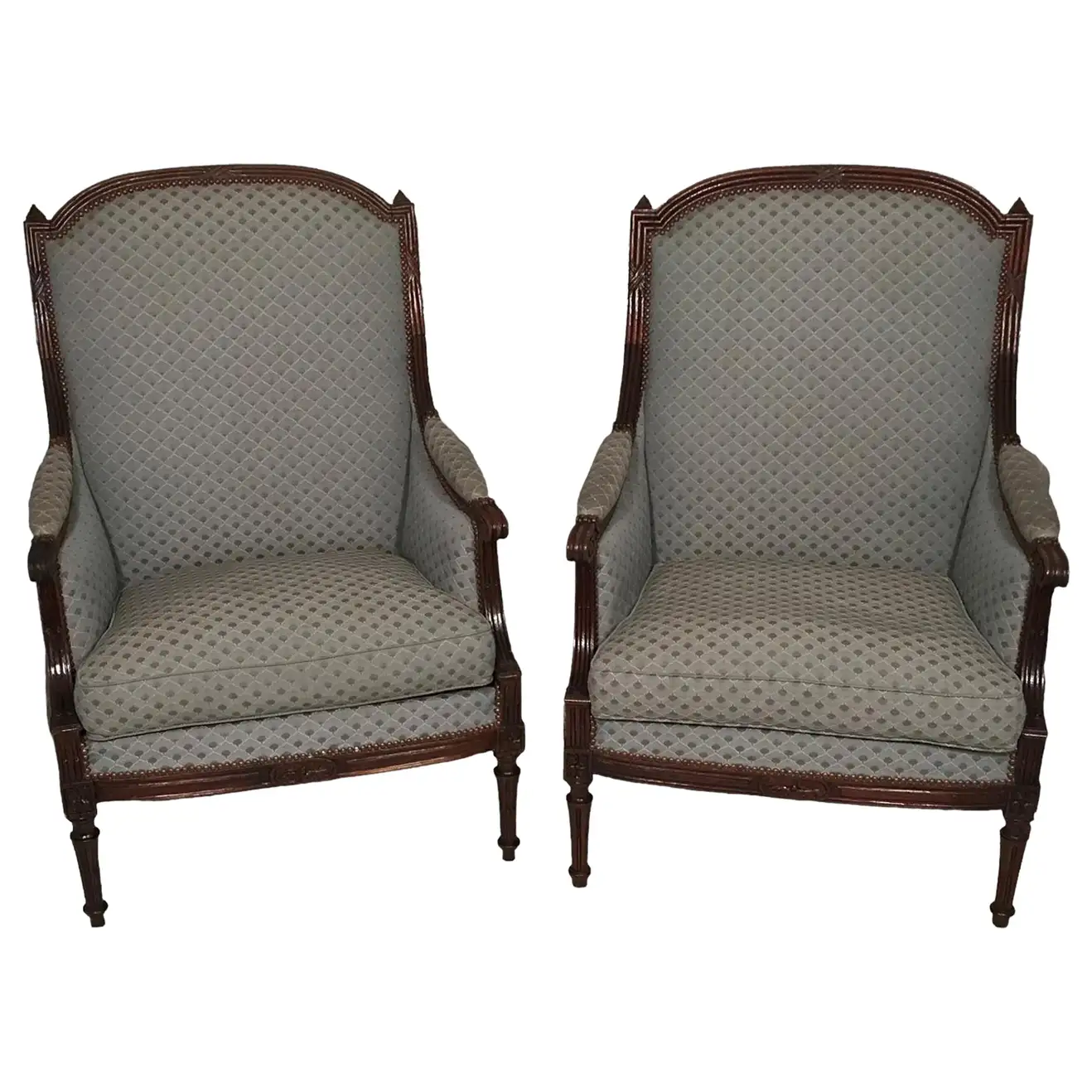

Pair of Louis XVI Style Bergéres- available on Styylish.com
Empire and Restoration Periods (1800–1830s)
-
Features: Stronger, bolder lines and heavier construction
-
Common motifs: Swans, eagles, lions, or Egyptian figures
-
Materials: Dark woods like mahogany, rich velvet or leather upholstery
-
Function: Grand, masculine pieces for empire-style interiors
-
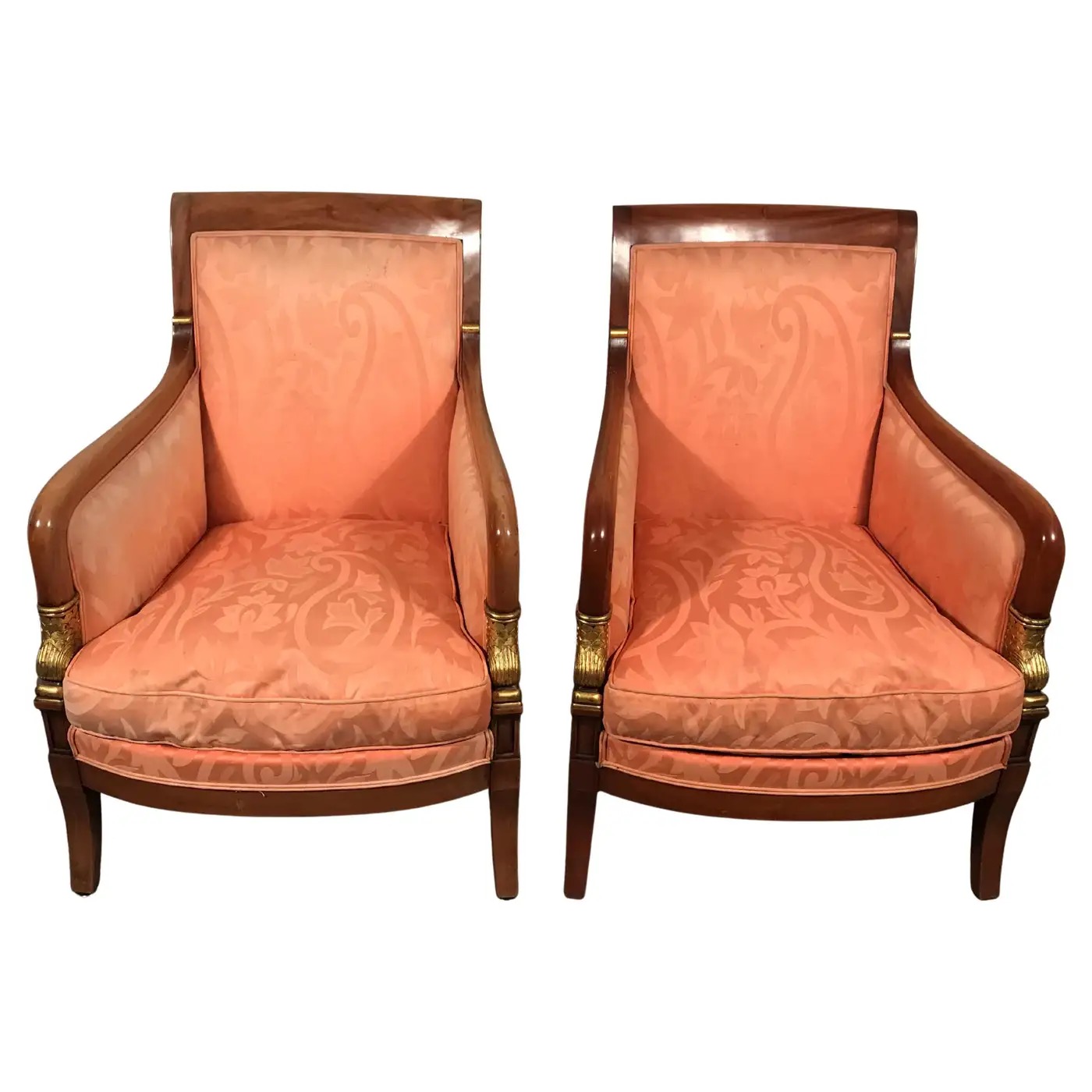

Pair of Empire-Style Bergère Chairs- available on Styylish
Though the style shifted, the Bergère always remained a chair designed for comfort, status, and aesthetic beauty.
Upholstery: Then and Now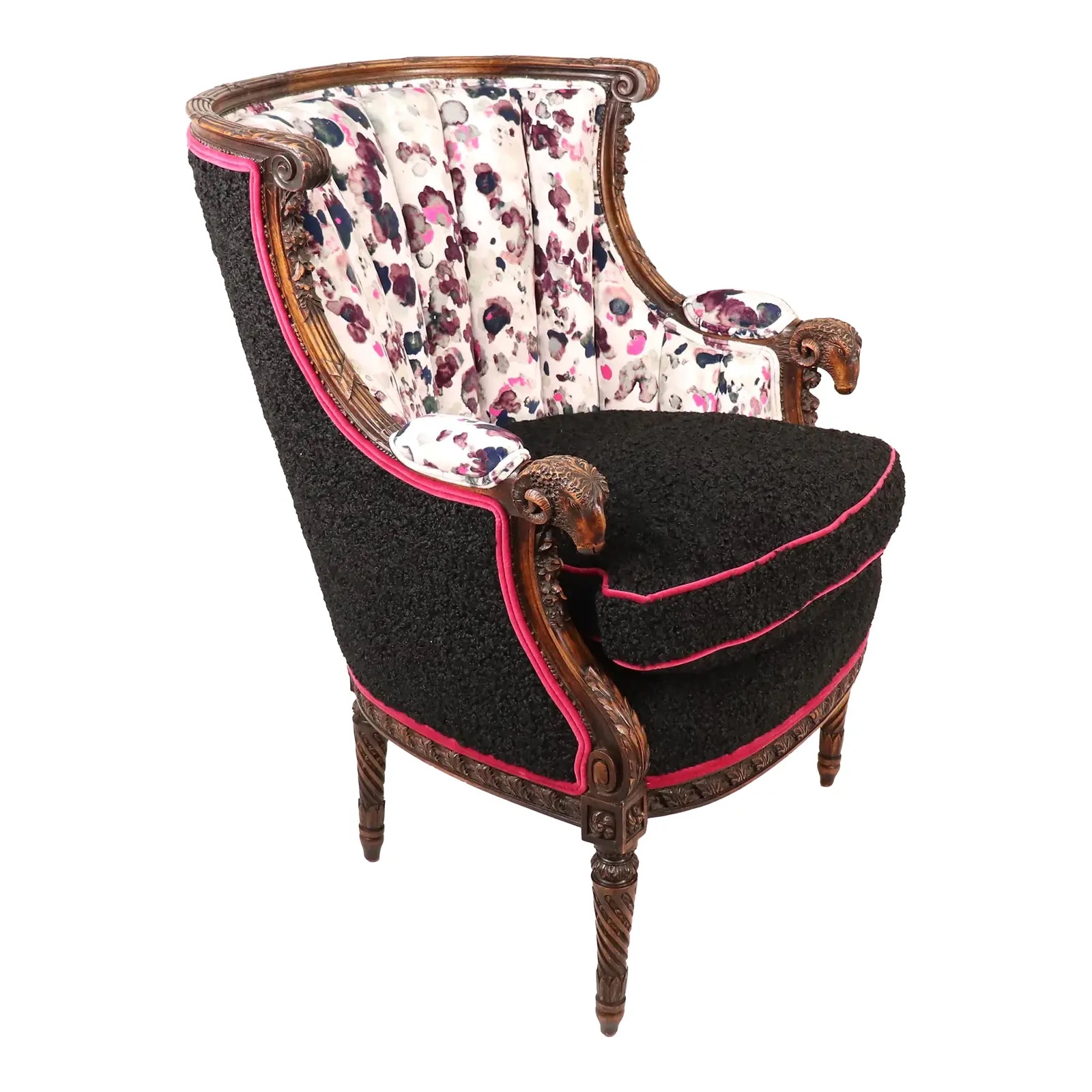

Originally, Bergère chairs featured tapestry upholstery, hand-painted silk, or damask fabrics. Makers often decorated them with braiding or brass nailheads to create a finished, tailored look. The loose seat cushion, a hallmark of the design, allowed for easy maintenance and additional comfort.
Today, interior designers love reupholstering antique Bergère chairs. Some stay true to history with period fabrics, while others go bold—pairing a Louis XV chair with modern graphic prints or velvet in jewel tones. At Styylish, many clients request professional refinishing or reupholstery to blend antique frames with their unique interior vision.
Why the Bergère Chair Stands the Test of Time
The Bergère chair continues to thrive in interiors for three key reasons: elegance, comfort, and versatility.
Its exposed wooden frame adds character to both traditional and contemporary rooms. The deep seat and curved arms make it ideal for reading, lounging, or conversation. Whether placed in a formal living room, a quiet corner, or beside a fireplace, the Bergère adds instant charm.
Designers love pairing Bergère chairs with marble-topped side tables, antique mirrors, or matching ottomans. They also use them as accent pieces in eclectic spaces—blending old and new effortlessly.
Tips for Styling a Bergère Chair Today
You don’t need to live in a château to enjoy a Bergère chair. Here are a few ideas for incorporating one into a modern home:
-
Classic Parisian Look: Place two Louis XVI Bergères in front of a marble fireplace. Add a gilded mirror and antique sconces for a cohesive French feel.
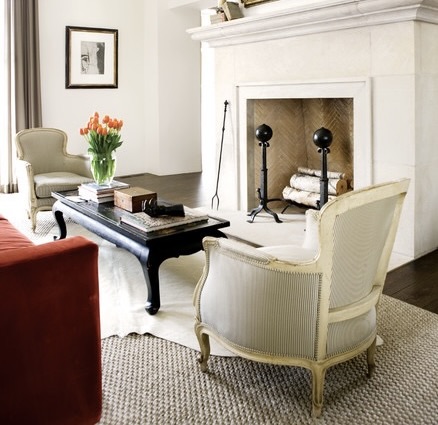

-
Modern Contrast: Reupholster an ornate Louis XV chair in a bold, modern fabric and place it in a minimalist space for dramatic contrast.


-
Reading Nook: Create a cozy corner with a Bergère, a wool throw, and a side lamp. Pair it with a low table and a stack of design books.
-
Bedroom Accent: Use a single Bergère at the foot of the bed or in a dressing room. Choose light upholstery for a serene, romantic vibe.
Wherever you place it, a Bergère elevates the space with its mix of elegance and comfort.
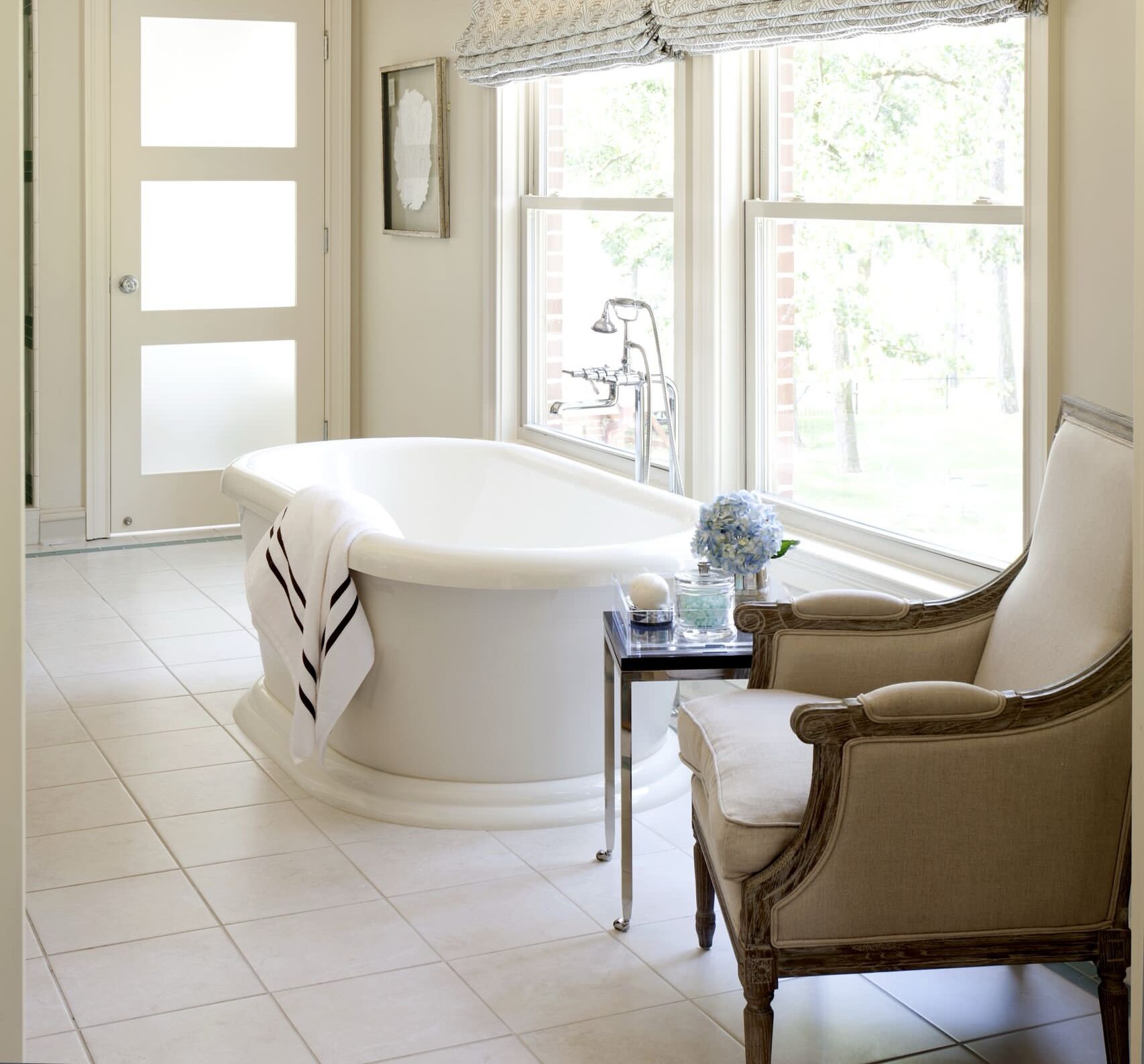

How to Shop for a True Antique Bergère
Not all Bergère chairs are created equal. Many reproductions exist, but true antiques—especially those from the 18th or early 19th century—offer unmatched craftsmanship and historical value.
When sourcing a Bergère chair, look for:
-
Signs of hand carving, not machine-made details
-
Old joinery methods (such as pegged joints or dowels)
-
Original patina or signs of age in the wood
-
Provenance or documented origin, when possible
At Styylish, we curate authentic antique Bergère chairs from across Europe. Our team carefully inspects each piece and offers refinishing services to meet your aesthetic preferences while preserving historical integrity.
Final Thoughts
The Bergère chair isn’t just furniture—it’s a symbol of comfort, beauty, and heritage. With origins in 18th-century France and a name that evokes pastoral elegance, it has graced aristocratic salons, royal residences, and modern design studios alike.
Whether you’re a seasoned collector or a new admirer of antique furniture, a Bergère adds soul and style to any room. Its graceful lines, deep comfort, and versatile silhouette make it one of the most timeless pieces in French design history.
Explore our collection of authentic antique Bergère chairs on Styylish.com and find the perfect piece to elevate your interior.


